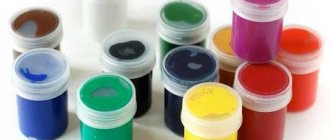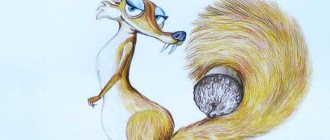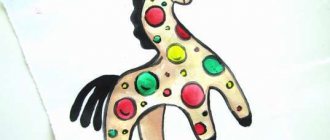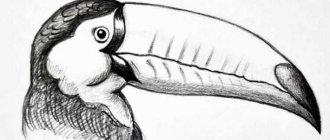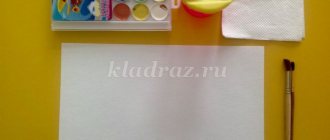MAGAZINE Preschooler.RF
Tasks:— continue to teach children to take care of household items;
— activate children’s vocabulary on the topic “Dishes”;
- consolidate the use of nouns in diminutive form;
- learn how to compose a composition yourself;
- develop technical skills - skillfully use a brush (paint with the tip of the brush, holding it in a vertical direction, with the whole brush, move freely in different directions)
- cultivate a desire to help people in difficult times.
Material and equipment:
multimedia, book by K.I. Chukovsky “Fedorino Grief”, ball, teapot and cup, Su-Jok springs, cut pictures, gouache, brushes, water jars, napkins, album sheets.
Preliminary work:
— reading the fairy tale by K. I. Chukovsky “Fedorino’s grief”;
- conversation about dishes;
- games with doll dishes.
GCD move:
Educator: - Guys, listen carefully, I will read you excerpts from one fairy tale (“Fedorino’s grief”)
Educator: - Did you recognize this fairy tale? What is it called? /"Fedorino's grief"
- Who wrote this fairy tale? / K.I. Chukovsky
Educator: - That's right, and now I suggest you watch a short excerpt from this cartoon.
Educator: (after watching) - Why did the dishes run away from Fedora? She didn’t wash her, beat her, etc.
— Why did the dishes decide to return to Fedora? The dishes took pity on Fedora, forgave, etc.
Educator: - Now, let's stand freely on the carpet and warm up. Physical exercise “Utensils” is being held.
Here is a big shiny teapot. Very important, like a boss. Here are the porcelain cups, very fragile poor things. Here are porcelain saucers, just knock and they will break. Here are the silver spoons, Here is the plastic tray - He brought us the dishes.
Educator: - Fedora broke a lot of dishes. And now I suggest you collect her dishes from the fragments.
D/I “Collect a picture”
Game task: collect a picture.
Progress of the game: children collect cut dishes on the table.
Educator: - Well done, you completed the task. Now stand in a circle. I will take turns throwing the ball to you and naming the dishes, and you will name them affectionately. Whoever names correctly sits down at the table.
Educator: - You guys remember that Fedora broke a lot of dishes. Let's help her and draw new dishes for her, namely a teapot and a cup.
Examining the teapot and cup.
Educator: - Let's stretch our Su-Jock fingers with springs before we start drawing.
Drawing of a cup and a teapot by children. Decorating them.
Questions for self-analysis of children:
—Which cup and teapot did you like best? Why?
—Which cup and teapot turned out to be the brightest? Why?
— What would you advise Fedora to do with the dishes after tea? And why? Wash the dishes so she doesn't run away from her again.
| Next > |
How to draw the fairy tale “Fedorino’s grief”?
I think everyone has read this interesting fairy tale, which is written in poetic form. What does the fairy tale say? That's right, about the fact that Fedora did not wash the dishes and did not tidy up the house, which is why all the utensils became alarmed and decided to leave the old woman.
That’s why I advise you to draw the old woman herself, who doesn’t look very neat, as well as the dirty dishes that go into the forest.
You can, of course, dream up your own imagination and draw a picture, or you can try to copy from the drawings that I attached just below. By the way, don’t forget that in the fairy tale Fedora (at the very end) became a rather clean grandmother, so you can draw a picture in which the grandmother, for example, washes the dishes.
And here are the pictures themselves for sketching:
My son was given an assignment in literary reading for 2nd grade to draw an illustration for K. Chukovsky’s work “Fedorino’s Mountain . Since he and I are both graphic artists, we resorted to the help of the Internet.
Here are the pictures we found.
Of course, you can depict only dishes, tables, glasses, and spoons that walk and jump, but I think Grandma Fedora must be captured, then such an illustration cannot be confused with any other fairy tale.
You can draw the following illustrations in pencil:
A large A3 format, for example, would be ideal. And you need to start the drawing from the center or approximately from the center.
If possible, you can draw a picture in paints or colored pencils.
The most colorful part of the fairy tale “Fedorino’s Grief” is the moment when all the household utensils run away from Fedora. It is this moment that is most often chosen for drawing. Fedora's cats actively participate in catching the dishes, and everyone is impressed by the pointing out cockroaches. Then you might end up with a picture like this:
I also find the image of all the utensils on the road interesting, and again, let’s not forget the cats:
Throughout the poem “Fedorino's Grief,” the main character, Fedora, changes dramatically and if at the beginning she appears as a complete slob, then at the end she corrected herself, and then all the escaped objects returned to her. This point can also be shown in the figure:
You can draw an old lady, and all the kitchen utensils you know are running around her or away from her.
Look how the kids did it.
The old woman is located in the center of the picture. And dishes are rushing around her.
You need to draw step by step like this:
I think that 7 drawings will be enough.
Usually young children are asked to draw a fairy tale based on Fyodor. Therefore, I will suggest drawing simple drawing options.
First option. Draw a wooden house. Draw Fedora standing next to her. And of course, next to her there are dishes running away from her, such as a samovar, plates, a kettle, a cup and an iron. As a result, you should end up with a simple drawing like this that any child can draw:
Second option. You can draw an episode when all the dishes run away from Fedora. Draw the floor, several trees. Numerous dishes that run away from her. Of course, you draw this drawing with various colored pencils. This should be a miracle:
The fairy tale “Fedorino's grief” is liked by many children; it is very instructive.
If you don’t wash the dishes, all the plates, cups and pots will scatter to either side of you.
You can paint scenes when all the kitchen utensils decided to run away from Fedora’s house, how disgusted they were with the careless housewife that they chose to leave the house.
We draw a hut window, and a samovar, plates, cups and glasses jump out of it.
You can also draw Fedora at this moment.
You can also draw the moment when Fedora became neat, she began to take care of the dishes: wash and dry them, and in return the dishes responded to her with deep gratitude.
Source
Who is who?
The guys and I drew pictures for our fairy tale, made syncwines and word clouds. This is what we got.
This is the work of Kostya S.
And this is the work of Alexander R.
This is how Tolik B presented the fairy tale.
And these are the works of Nastya Sh.
Meet! Our syncwines!
Fedora. Fedora.
Lazy, unclean. Lazy, sloppy.
Didn't wash, didn't wash, didn't care. It got dusty, smoked, ruined.
Those who do not value hygiene will then howl like a hyena. Dishes love cleanliness.
Corrected. Kostya S. Has changed. Dasha K.
We present to your attention an excerpt from the fairy tale “Fedorino's grief”. Unfortunately, Nastya Sh was unable to take part in the recording of the fairy tale. When she gets better, we will definitely listen to the fairy tale together.
Our impressions of working in the project
The most interesting thing about the project was:
conduct a survey among children and adults about the fairy tales of K.I. Chukovsky;
draw pictures based on the fairy tale “Fedorino’s grief”;
record the audio tale “Fedorino’s grief.”
Publications on the topic:
Summary of an integrated lesson based on the fairy tale by K. Chukovsky “Fedorino's Mountain” Methodological development based on the fairy tale by K. Chukovsky “Fedorino's Mountain” Objectives: 1. To cultivate frugality in children, a love of cleanliness and neatness. 2. Review the vocabulary.
Summary of an integrated lesson in the senior group “Fedorino Gore” Synopsis of an integrated lesson in the senior group “Fedorino Gore” (conversation) Purpose: To develop social skills and skills for a healthy lifestyle in children. Tasks.
"Fedorino's grief." Summary of a comprehensive lesson in the middle group on the lexical topic “Utensils” Goal: to clarify and consolidate children’s knowledge about utensils. Objectives: 1. Learn to classify utensils. 2. Give an idea of what dishes are made of. 3. Develop.
Conducting a survey
1. We presented the results of education for children and adults in the form of a diagram
2. Among the most famous fairy tales were the following:
15 people out of 27 respondents chose the fairy tale “Aibolit”.
We have compiled a word cloud based on the fairy tales of K. I. Chukovsky
And this is what children and adults said about fairy tales:

